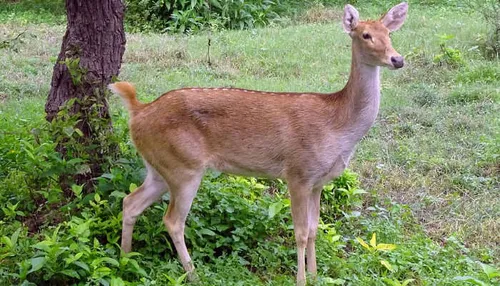
Sitamata Wildlife Sanctuary: Rajasthan’s Untouched Wilderness
Sitamata Wildlife Sanctuary, located in southeastern Rajasthan, is a nature lover’s paradise. Spread over 423 sq. km, this diverse ecosystem is home to leopards, sambar deer, chital, langurs, and a vast array of bird species. Its dense forests, rolling hills, and serene water bodies make it a must-visit destination for wildlife photographers, birdwatchers, and eco-tourists.
Why Visit Sitamata Wildlife Sanctuary?
✔ Untouched Natural Beauty – One of Rajasthan’s lesser-explored wildlife reserves, offering a peaceful escape into nature.
✔ Rich Biodiversity – Home to rare mammals, exotic bird species, and reptiles, making it a haven for wildlife lovers.
✔ Perfect for Birdwatching – Spot Indian Peafowl, raptors, kingfishers, and other migratory birds in their natural habitat.
✔ Serene Water Bodies – The sanctuary is nourished by the Sitamata and Chambal Rivers, providing a lush, green landscape.
✔ Wildlife Safari & Nature Trails – Enjoy guided safaris and trekking trails for an up-close experience with nature.
Wildlife of Sitamata Sanctuary
Sitamata Wildlife Sanctuary is one of the richest biodiversity spots in Rajasthan, offering a mix of dry deciduous forests, grasslands, and riverine habitats that support a wide range of species.
A Diverse Landscape
Sitamata Wildlife Sanctuary features a range of diverse and picturesque landscapes:
- Forested Terrain: The sanctuary is predominantly covered in dense forests, which are rich in flora and provide a crucial habitat for a variety of wildlife. The lush greenery offers a beautiful contrast to the surrounding arid regions.
- Hilly Terrain: The landscape includes rolling hills and valleys that contribute to the sanctuary’s scenic beauty and ecological diversity.
- Water Bodies: Several rivers and water bodies, including the Sitamata and the Chambal rivers, flow through the sanctuary. These water sources are vital for wildlife, particularly during the dry season.
Wildlife: A Rich Array
Sitamata Wildlife Sanctuary is home to a diverse range of wildlife, making it an intriguing destination for nature enthusiasts:
Mammals:
- Leopards: Leopards inhabit the sanctuary and can occasionally be spotted in the dense forests. They are elusive but add a thrilling element to wildlife sightings.
- Chital (Spotted Deer): These graceful deer are commonly seen in the sanctuary, often grazing in open areas or moving through the forest undergrowth.
- Sambar Deer: Sambar Deer are another significant herbivore in the sanctuary, typically found in the more forested regions.
- Wild Boars: Adaptable and common, Wild Boars are frequently seen foraging in the sanctuary’s diverse habitats.
- Langurs: The sanctuary is also home to several species of Langurs, which are often seen in the forest canopy.
Birds:
- Avian Diversity: Sitamata is a great location for birdwatching, with a variety of bird species inhabiting its forests and water bodies. Notable species include the Indian Peafowl, various raptors, and waterfowl.
Reptiles:
- Snakes and Lizards: The sanctuary hosts various reptile species, including snakes and lizards that play an important role in the ecosystem.
Flora:
- Vegetation: The flora of Sitamata includes a mix of tropical and subtropical trees, shrubs, and grasses. Common species include Teak, Sal, and various types of bamboo, which provide essential cover and resources for the wildlife.
Activities and Attractions
Wildlife Viewing: The primary attraction of Sitamata Wildlife Sanctuary is wildlife viewing. Guided tours offer opportunities to explore the sanctuary’s diverse landscapes and observe the local fauna. Early mornings and late afternoons are the best times for wildlife sightings.
Bird Watching: With its rich avian population, Sitamata is ideal for birdwatching. Bring your binoculars and camera to spot various bird species and enjoy the sanctuary’s peaceful environment.
Photography: The sanctuary’s picturesque landscapes, lush forests, and diverse wildlife make it a fantastic location for photography. Capture the beauty of the animals, the charm of the birds, and the serenity of the water bodies.
Nature Trails: Explore nature trails that offer a closer look at the sanctuary’s flora and fauna. These trails provide an immersive experience of the area’s natural beauty.
Water Bodies: The rivers and lakes within the sanctuary not only enhance the landscape but also provide opportunities for observing wildlife around these water sources.
Best Time to Visit Sitamata Wildlife Sanctuary
✔ October – March: Best for wildlife sightings & birdwatching, with pleasant weather.
✔ April – June: Summer months (hot but great for spotting animals near water sources).
✔ Monsoon (July – September): Lush greenery but restricted access due to heavy rains.
Sitamata Wildlife Sanctuary offers a serene and enriching wildlife experience, with its lush landscapes, diverse wildlife, and peaceful environment. Whether you’re exploring the sanctuary’s flora and fauna, enjoying birdwatching, or capturing the scenic beauty through photography, Sitamata promises a memorable visit. Its tranquil setting and commitment to conservation make it a valuable destination in Rajasthan’s wildlife landscape.
Final Thoughts – Why Sitamata Wildlife Sanctuary is a Must-Visit?
Sitamata Wildlife Sanctuary is an untouched paradise for nature lovers. Whether you’re tracking wildlife, capturing rare birds through your lens, or simply soaking in the serenity of Rajasthan’s forests, this sanctuary promises a soul-refreshing experience.
🌿 Escape the crowds, reconnect with nature, and explore one of Rajasthan’s best-kept secrets!
